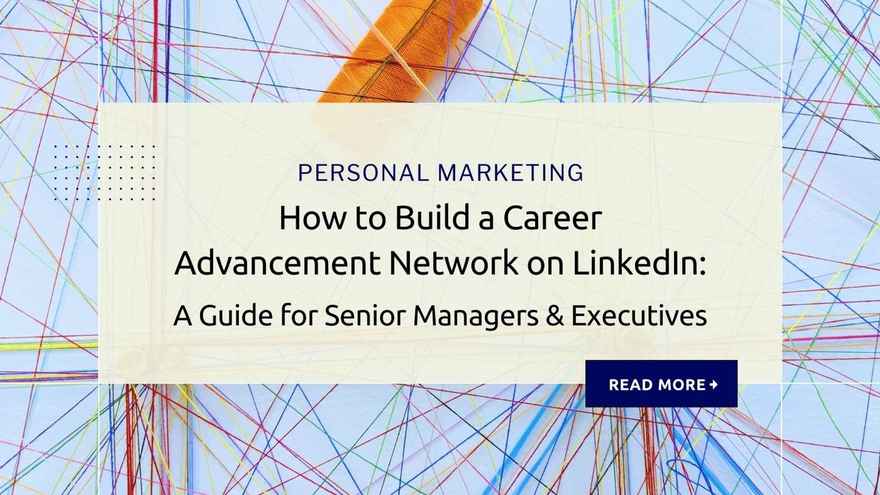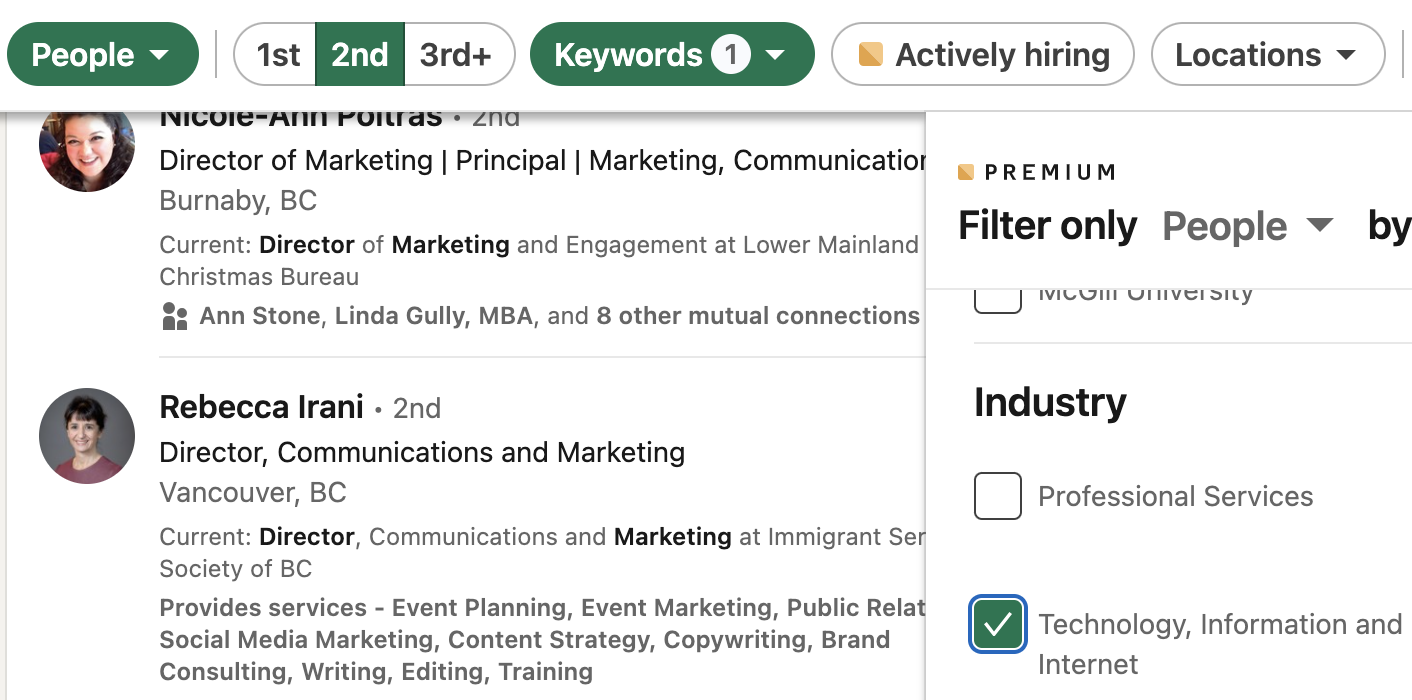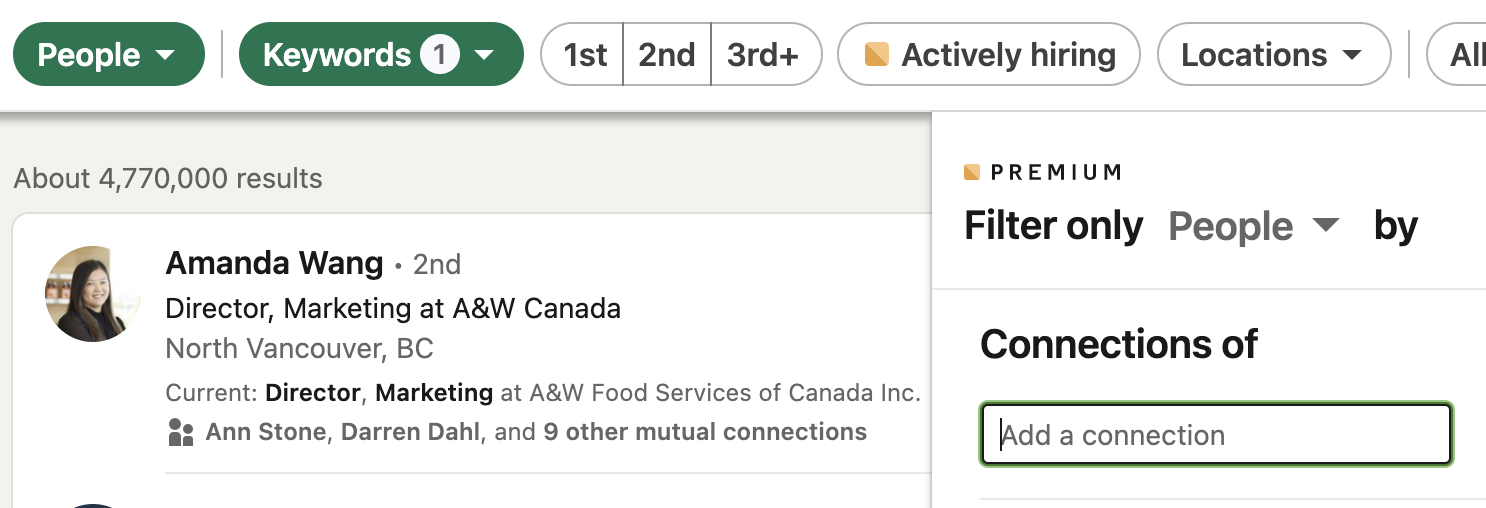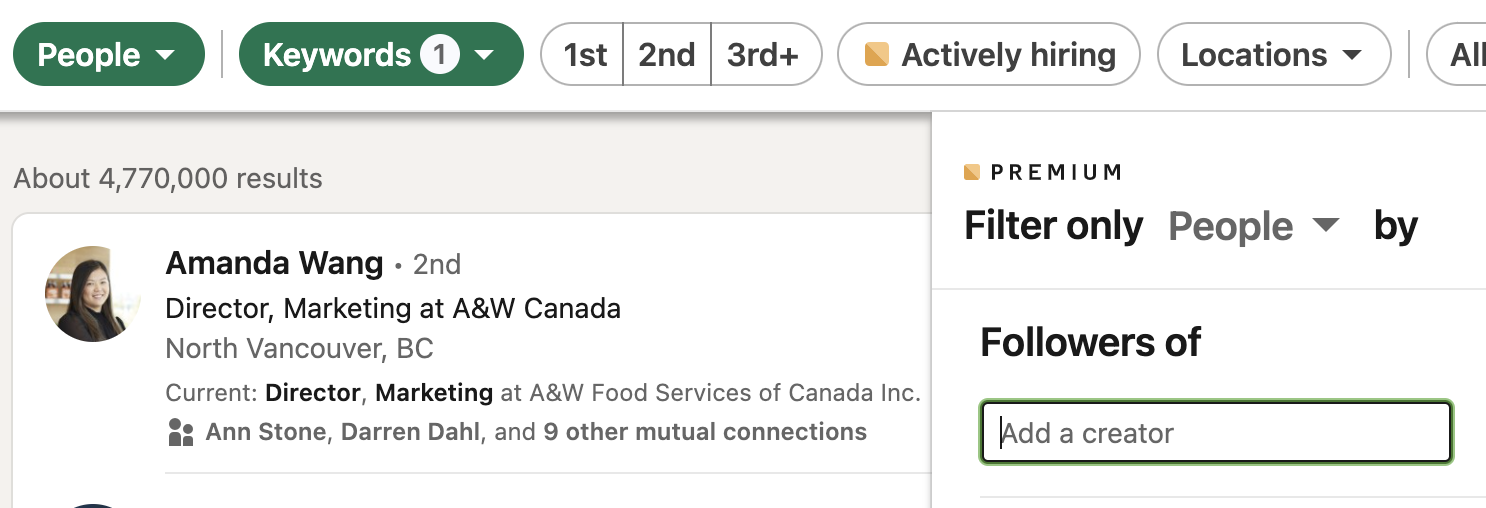Career Coaching & Career Advice Blog
The articles you need to create
a successful and fulfilling career journey.
How to Network on LinkedIn: Guide for Managers & Executives

LinkedIn is a vital platform for senior managers and executives looking to advance their careers. However, with millions of users vying for attention, how can you distinguish yourself and forge connections that expand your network and enrich your professional life?
This article offers strategies tailored to senior professionals, focusing on creating meaningful connections, leveraging LinkedIn’s tools effectively, and engaging in activities that deepen professional relationships.
Table of Contents
- Common Challenges in Building a Professional Network on LinkedIn
- Understanding the Value of Meaningful Connections in Your Network
- How to Find People to Network with on LinkedIn
- How Executives and Managers can Build and Strengthen their Professional Network
Common Challenges in Building a Professional Network on LinkedIn
Networking, especially on a professional platform like LinkedIn, can seem daunting even to the most experienced professionals. Understanding these challenges is the first step to overcoming them and effectively using LinkedIn for career advancement.
Fear of Rejection
One of the most common barriers to networking is the fear of rejection. Many professionals hesitate to contact others because they worry their connection request will be ignored or declined. Senior managers and executives must recognize that rejection is not a personal reflection of their worth but a part of the networking process. Set the expectation that you will hear back from some people, not all. Embracing a mindset that values each interaction as a learning opportunity can mitigate the fear of rejection.
Misconceptions About Networking
Many individuals hold the misconception that professional networking is inherently self-serving or opportunistic. This view can deter engaging with others openly and authentically. Successful networking, however, is based on mutual benefit and genuine relationship-building. Shifting focus from gaining immediate benefits to offering value and support to others can transform your networking approach and outcomes.
Time Constraints
Senior managers and executives often face significant time constraints, making it challenging to dedicate time to build and maintain a professional network. However, integrating networking activities into your daily routine can make this process more manageable. Allocating a specific time each week for LinkedIn activities such as commenting on posts, sending messages to new connections, and updating your profile can ensure consistent networking efforts without overwhelming your schedule.
Overcoming Introversion
For many introverts, initiating conversations and making new connections can be particularly challenging. Leveraging LinkedIn allows for more controlled interactions that can be undertaken and sustained comfortably. Starting with liking or commenting on posts can be a less intimidating way to begin engaging with new contacts before moving on to more direct communication.
Understanding and strategically addressing these challenges can greatly enhance your networking effectiveness on LinkedIn. By acknowledging and overcoming these hurdles, you can expand your professional network in a way that is both fulfilling and beneficial to your career advancement.
Understanding the Value of Meaningful Connections in your Professional Network
Quality Over Quantity. For senior managers and executives, building your network on LinkedIn should not merely involve collecting connections. Instead, you should focus on creating a network that is rich in quality and relevance.
Remember, LinkedIn is a partial and digital representation of your network. There are people in your network who are not on LinkedIn. You connect with people you know in the offline world and create new connections with people you’d like to know.
Numbers also matter. Based on how the LinkedIn database is structured (degrees of separation), and the power of keyword search, all things being equal, a more extensive LinkedIn network equates to greater exposure and ROI for your time on LinkedIn.
Engage with connectors. From a network database perspective, each connection is not equally valuable. Relationships with someone who is highly connected in an industry, market or city, have an outsized effect on the ROI of your LinkedIn efforts.
What you do with each connection matters the most. It only takes one referral, one transformation conversation, one job offer to shift the trajectory of your career. An executive who leverages 175 highly meaningful LinkedIn connections will get more ROI than someone with 750 who doesn’t engage.
How to Find People to Network with on LinkedIn
Section contents
- Who to Network With: Network Expansively But Relevantly
- Who to Network With: 27 Categories of People to Network with on LinkedIn
- Utilizing LinkedIn’s Search Tools to Your Advantage
Who to Network With: Network Expansively But Relevantly
Expanding your network doesn't mean connecting with everyone. Instead, choose connections that align with your career goals, industry and interests. Here’s my advice:
- “Map” your current industry or target domain and network intentionally
- Network locally outside your industry with “good people”
- Network outside your local geography particularly in your industry or target domain and with influencers who have powerful networks
See below for specific ideas.
Who to Network With: 27 Categories of People To Network with on LinkedIn
“Build your network” can sound nebulous. With who? People in your network should have one or more of the following qualities:
- You have a rapport with them
- You know, like, trust
- You worked together or on something
- You have a shared affiliation or shared interest
- They could potentially advance your professional (or volunteer) goals
- You could potentially help them
Here’s a list of what I call “networking vectors”. Work through these, to systematically expand your LinkedIn network.
- Current colleagues (senior, peer, subordinates)
- Past colleagues (senior, peer, subordinates)
- Friends and acquaintances (yours, your partner’s)
- Clients and customers
- Vendors and professional services firms
- Personal service providers like your accountant, lawyer, banker, etc.
- People in your industry locally
- People in your industry regionally or nationally
- People in adjacent industries
- People in industries you are attracted to
- People in your profession or area of expertise
- Target organizations - peers, hiring executives, talent attraction manager
- Executive recruiters
- Internal recruiters
- Executive coach or career coach
- Board members
- Financing firms
- Professional association people
- People you shared a professional development experience
- Alumni from your formal education
- People with compelling backgrounds that you’d like to know
- Shared charitable cause commitment
- Shared personal interest
- Offline groups - sports, social, music,
- Authors, online creators, speakers and others with a voice and an audience
- People referred to you by your network
- People who visit your profile
Utilizing LinkedIn’s Search Tools to Your Advantage
LinkedIn’s search functionality is a powerful tool for pinpointing the right contacts. Use industry, company size, job title, and location filters to discover potential connections that can directly influence your career trajectory. Understanding these features allows you to efficiently navigate the vast network and connect with the right individuals.
Use Advanced Search Tools: Utilize LinkedIn’s advanced search features to find individuals in key positions within your industry or in related fields. Keywords, locations, current companies, and past roles can refine your search to the most relevant professionals. Here are a few prompts to get better results:
To find new people in your industry with shared connections: People > 2nd degree > Industry > (location). Add a job title to refine further.

To search for people connected to someone, use the advanced filter "Connections of" shown below.

If you follow or are connected to someone who posts a lot, they have creator mode turned on. To find other people who follow that creator, use the advanced filter shown below.

To find key people in an industry or organization, search by organization, job titles, and then view people

To find people actively hiring, either your connections or 2nd or 3rd degree connections, activate the "Actively hiring" feature.

Finally, be sure to use Boolean search terms to get better results. Boolean searching uses operators: words like AND, OR, and NOT. These are logic-based words that help search engines narrow down or broaden search results. Example:
- (VP OR Director) AND (HR OR Human Resources) AND DEI should return either jobs or people that have one of those titles in HR where DEI is mentioned in their profile.
How Executives & Managers Can Build and Strengthen a Professional Network
Section contents
- 10 Easy Ways to Create Stronger Relationships with your Existing LinkedIn Connections
- How to Connect With New People on LinkedIn
- How to Attract New People to Your Network with your LinkedIn Profile
- How to Attract New People to Your Network with your LinkedIn Activity
10 Easy Ways to Create Stronger Relationships with Your Existing LinkedIn Connections
While having passive connections on LinkedIn can have database benefits, I see these loose connections as untapped potential. Every connection represents a relationship opportunity, and relationships are a key driver of a successful career.
Don’t aim for a deep relationship. That is a result of time, attention and other factors. Instead, focus on establishing mutual interest in knowing each other and permission to contact them.
Here are ten easy ways to develop and deepen your professional relationships on LinkedIn.
- Visit profiles: Develop a practice of getting to know the profiles of people in your network. Familiarize yourself with their professional background and interests and maybe understand their goals. The trick: How can you potentially help them? Or what points of common interest do you share?
- Thinking of you: Send a quick hello or check-in message. Ask them about their progress.
- Refer a resource: If you share overlapping industries, professions, or interests, you may know of a resource to share.
- Update them on your progress: Share what you've been up to professionally, which can open the door to new collaborative opportunities.
- Have a conversation: For high-priority connections, reach out to schedule that coffee meeting, call or email exchange to catch up or discuss a specific topic.
- Engage with their content: If someone has taken the time to write or share a post, they want people to see it. The more comments, the more LinkedIn rewards the post with increased distribution. You can do someone a service by commenting on their content (minimum 5 words for it to count). Do this a few times, and they will be grateful.
- Make a recommendation: Recommendations on LinkedIn are tremendous for building the “Know - Like - Trust” factor. For relationships where you’ve had a working relationship with someone AND are a fan, offering to do a recommendation can be profoundly impactful.
- Endorse skills: Where you have confidence that your connection has a particular skill or expertise area, support their branding efforts with your endorsement. It takes just a few seconds.
- Refer an opportunity: If you know the goals of one of your relationships (career change, job search, business referrals, speaking opportunities), try and refer when the occasion arises. Referrals are a high-value activity; they’ll be grateful you thought of them.
- Make (or ask for an introduction): Become more valuable in the network as a connector. Someone who knows people and who brings people together. When you know two people you think would mutually benefit from meeting each other, make the introduction. Write about the overlapping interests and talk up the achievements of each individual. Everyone wins.
Relationships are key! LinkedIn functions like your CRM. Develop the practice of better understanding your existing network through regular profile visits and follow-ups.
How to Connect With New People on LinkedIn
Connecting with new people on LinkedIn requires a thoughtful approach. The overarching rule? Engage first. Never send a blind connection request. A connection should the the result of interactions, not the starting point.
How and when you reach out to new people on LinkedIn depends on how warm they are, your relative positions, and what value you have to offer them.
- Warm vs. cold: With meaningful shared interests, mutual friends, or a recommendation from a shared relationship, you can feel comfortable sending a Direct Message without the recommended warm-up activities below.
- Position: While not a fixed rule, in general, you can be more direct with people “junior” to you at a professional level and less so with people “senior” to you.
- Value: If you want to contact someone outside your current network with something of potential value to them, particularly when you have a time-sensitive offer, you should try and approach them directly.
Here are the steps:
- Follow: You can “follow” people. This does a few valuable things. It sends a signal to the person that you’re interested in them. It also prioritizes any content they post in your feed. This is an excellent first step.
- Engage: If possible, engage with the potential connection’s content and ensure your interaction provides value. This could be through insightful comments, sharing their content, or participating in discussions they’re involved in. Examples:
- Commenting on posts is not just about visibility—it’s about showing genuine interest in someone's professional opinion. Well-thought-out comments can spark conversations and lead to stronger connections. This approach helps establish your thought leadership and keeps you top-of-mind among your connections.
- If they are hiring, share their posting with your network.
- Get referred: An introduction - ideally, a three-way message from someone they respect opens doors.
- Direct messaging: DMs are your friend and incredibly powerful. The warmer the connection, the easier the DM. The colder, the more emphasis you need to put on the wording of your message.
- Be a human: Ideally, you are engaging in some form of a conversation - face-to-face, via video call, text or email. Be interested and interesting.
- Personalize connection requests: When connecting is appropriate, always include a personalized message.
How to Attract New People to Your Network with your LinkedIn Profile
So far, we’ve covered your outbound LinkedIn networking efforts. You also want to attract people to your network. People find you through your activity (see next section), through referrals, and through search.
Your LinkedIn profile is a critical piece of the network-building puzzle. Each visit to your profile is an opportunity. For your LinkedIn profile to be a network builder, you need:
- Volume of relevant visitors
- And your profile needs to make a strong impression (which translates into conversion..the likelihood someone will reach out to you)
Note: While I recommend that all senior managers and executives put effort into an on-brand, optimized LinkedIn profile, the reality is that if you hold a current position with a title and organization that is prestigious where people want to network with you, it is easier for you to attract interest.
Being found by a search is a function of keywords. The three top categories of keywords searched for by executive recruiters, internal recruiting teams, or anyone trying to find someone on LinkedIn to solve a problem, are:
- Job title
- Industry or market
- Area of expertise or skill (rarer, in-demand ones, not commonplace skills)
I’ve written about the components of a powerful LinkedIn profile. Briefly, here’s what you need to be found:
- Headline: Should be both findable and compelling. While there are different formulas, one that stands the test of time is {job title} + {industry or market} + {descriptor, your how, or focus}. Your headline and job titles in your experience section are the most powerful keywords in the LinkedIn algorithm.
- Banner and headshot: Get a professional, personable headshot and take the time to identify or create a banner image at the top. Either as a finishing touch or an extra branding element.
- About: This is your chance to summarize who you are professionally and your direction. It can have some personality. Your About section should make clear what you are focused on.
- Experiences: I recommend you organize your experiences (nest multiple jobs at the same employer) and then write descriptions for each role - something like 2-5 lines of text plus a few key wins if appropriate. It is your chance to position the experience.
- Skills: You can display this section or not. Recruiters who post jobs on LinkedIn can scan an applicant’s submission by the number of matching skills. This is a powerful section if you anticipate being in the job market. Skills only count if they’ve been endorsed.
- Other: Your credentials, education, publications, and other optional sections can be powerful brand builders, depending on what assets you have to display.
- Voice and activity: It is easy to spot inactive LinkedIn profiles. Don’t let that be you. Think of your LinkedIn activity as a vehicle for expressing your brand—who you are, what problems you solve, for what markets, and what you care about. Your activity related to your current job indicates how you’d support a future employer. See below for specific activities.
How to Attract New People to Your Network with your LinkedIn Activity
Most LinkedIn users have a profile and do nothing else. That’s not going to be you. Your activity can be the driver of your ROI on LinkedIn.
Activity refers to what you post, share, like, or comment on.
There are two categories of topics that will attract people to your orbit:
- Related to current job: There’s an opportunity (and need) to be a leader in your current work. How does this help your network building? Your activity as a leader is attractive. People following your company will notice you. The industry will see you. By serving your company, you serve yourself.
- Post or share hiring opportunities
- Post or share company or team achievements, kudos
- Promote an event
- Share company news
- Related to your expertise or things you care about: You have expertise. You want to be known for something. You care about specific issues. You are interested in some subjects. This is what you post about.
Build your network with these activity types:
- Create content: You can create original content through a post, an article, or a newsletter. Posts can be text, video, documents, polls, images, or a combination of these.
- Share and engage on your content: You can share or repost other people’s or another organization’s content. This can be because you think it is valuable to your network or because you have a point of view you want to share.
- Engage on other people’s content: You can (and should) engage with the content of people in your network or those you follow. Likes aren’t engagement and will do nothing for your network building. The focus is on comments - both an original comment to their content, or a reply to a comment thread in the post or article. As outlined earlier in the article, this can be a powerful relationship-building strategy. Commenting is also a powerful way of getting your name and expertise out in the market. People will notice you, and your profile will be viewed more frequently.
Conclusion
LinkedIn offers a dynamic platform for career growth and networking for senior managers and executives. By focusing on meaningful connections, employing strategic engagement practices, and utilizing LinkedIn’s comprehensive tools, you can transform your professional network into a significant asset for career advancement. Remember, the key to success on LinkedIn lies in being proactive, selective, and genuine in every interaction. Start today by re-evaluating your LinkedIn strategy with these advanced tactics, and watch your professional network grow in strength and relevance.
Categories
- Announcements (3)
- Career Advancement (2)
- Personal Marketing Articles (32)
- Executive Job Search Articles (31)
- Executive Career Management Articles (39)
- Personal Leadership Articles (17)
- Executive Resume Articles (13)
- Career Paths & Models Articles (8)
- Tools & Resources (3)
- Personal Value Proposition Articles (7)
- Interview Skills Articles (7)
- Career Assessment Articles (4)
- Career Change Articles (5)
- Career Transition Articles (4)
- Personal Development Articles (3)
- Personal Branding Articles (1)
- Career Development Articles (3)
Start with my FREE crash course to build your Bold Career
